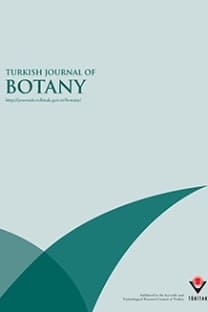Seed morphology and surface microstructure of some Euphorbia (Euphorbiaceae) taxa distributed in Turkey-in-Europe
Turkey, SEM, stereomicroscope, caruncle, globules, lipid globules
Seed morphology and surface microstructure of some Euphorbia (Euphorbiaceae) taxa distributed in Turkey-in-Europe
Turkey, SEM, stereomicroscope, caruncle, globules, lipid globules,
___
- Baiges JC, Espadaler X, Blanche C (1991). Seed dispersal in W Mediterranean Euphorbia species. Botanika Chronika 10: 697–705.
- Barthlott W (1981). Epidermal and seed surface characters of plants: systematic applicability and some evolutionary aspects. Nord J Bot 1: 345–355.
- Baytop A, Ertem G (1971). The genus Euphorbia in Turkey-in- Europe. İstanbul Eczacılık Fakültesi Mecmuası 7: 42–55.
- Bojňanský V, Fargašová A (2007). Atlas of seeds and fruits of Central and East-European Flora. 1st ed. Dordrecht, Netherlands: Springer.
- Can L, Erol O, Challen G, Küçüker O (2012). On the rediscovery of Euphorbia amygdaloides subsp. robbiae and its type. Turk J Bot 36: 650–654.
- Ehler N (1976). Mikromorphologie der Samenoberflächen der Gattung Euphorbia. Plant Syst Evol 126: 189–207 (in German with an abstract in English).
- Espadaler X, Gomez C (1996). Seed production, predation, and dispersal in the Mediterranean myrmecochore Euphorbia characias (Euphorbiaceae). Ecography 19: 7–15.
- Gomez C, Espadaler X (1998). Seed dispersal curve of a Mediterranean myrmecochore: influence of ant size and the distance to nests. Ecol Res 13: 347–354.
- Khan MS (1964). Taxonomic revision of Euphorbia in Turkey. Notes from the Royal Botanic Garden, Edinburgh 25: 71–161.
- Levin DA (1974). The oil content of seeds: an ecological perspective. The American Naturalist 108: 193–206.
- Mandl K (1926). Beitrag zur Kenntnis der Anatomie der Samen mehrerer Euphorbiaceen-Arten. Österr Bot Z 1–3: 1–17 (in German).
- Narbona E, Arista M, Ortiz PL (2005). Explosive seed dispersal in two perennial Mediterranean Euphorbia species (Euphorbiaceae). Am J Bot 93: 510–516.
- Pahlevani AH, Akhani H (2011). Seed morphology of Iranian annual species of Euphorbia (Euphorbiaceae). Bot J Linn Soc 167: 212–234.
- Park KR (2000). Seed morphology of Euphorbia section Tithymalopsis (Euphorbiaceae) and related species. J Plant Biol 43: 76–81.
- Pemberton RW, Irving DW (1990). Elaiosomes on weed seeds and the potential for myrmecochory in naturalized plants. Weed Science 38: 615–619.
- Radcliffe-Smith A (1982). Euphorbia L. In: Davis PH, editor. Flora of Turkey and the East Aegean Islands, Vol. 7. 1st ed. Edinburgh, UK: Edinburgh University Press, pp. 571–630.
- Royal Horticultural Society (2007). Royal Horticultural Society Colour Charts, 5th ed. London, UK: Royal Horticultural Society; Leiden, NL: Flower Council of Holland.
- Rössler L (1943). Vergleichende Morphologie der Samen europäischer Euphorbia-Arten. Beiheften zum Botanischen Centralblatt 62: 97–174 (in German).
- Salmaki Y, Zarre S, Esser H, Heubl G (2011). Seed and gland morphology in Euphorbia (Euphorbiaceae) with focus on their systematic and phylogenetic importance, a case study in Iranian highlands. Flora 206: 957–973.
- Singh RP (1969). Structure and development of seeds in Euphorbia helioscopia. Bot Mag Tokyo 82: 287–293.
- Suda CNK, Giorgini JF (2000). Seed reserve composition and mobilization during germination and initial seedling development of Euphorbia heterophylla. Revista Brasileira de Fisiologia Vegetal 12: 226–245.
- Uruşak EA, Özhatay FN, Güler N, Ersoy H, Başak N, Yeşil Y, Oral D, Demirci S (2013). The flora of Yıldız Mountains (Kırklareli) Biosphere Project area. Turk J Bot 37: 225–269.
- Yang Y, Berry PE (2011). Phylogenetics of the Chamaesyce clade (Euphorbia, Euphorbiaceae): reticulate evolution and long- distance dispersal in a prominent C4 lineage. Am J Bot 98: 1486–1503.
- ISSN: 1300-008X
- Yayın Aralığı: 6
- Yayıncı: TÜBİTAK
Kolyo DANKOV, Georgi RASHKOV, N. Amarendra MISRA, Emilia L. APOSTOLOVA
Diego BOGARIN, Adam P. KARREMANS
Levent CAN, Levent CAN, Orhan KÜÇÜKER
Violeta İ. SIMÃ"N-PORCAR, Ernesto PEREZ-COLLAZOS, Pilar CATALAN
Gülay Ecevit GENÇ, Taner ÖZCAN, Tuncay DİRMENCİ
GIORGIO LALLI, MARCO LEONARDI, MARILENA ODDIS, GIOVANNI PACIONI, ELENA SALERNI, MIRCO IOTTI, ALESSANDRA ZAMBONELLI
The modified qualities of basil plants by selenium and/or ascorbic acid
Zahra Oraghi ARDEBILI, Narges Oraghi ARDEBILI, Sara JALILI, Somayeh SAFIALLAH
SOPHIA BARINOVA, MARYIO BOBOEV, HIKMAT HISORIEV
Muhammad Adnan SHAHID, Rashad Mukhtar BALAL, Muhammad Aslam PERVEZ, Tahira ABBAS, Muhammad Anjum AQUEEL, Muhammad Mansoor JAVAID, Francisco GARCIA-SANCHEZ
